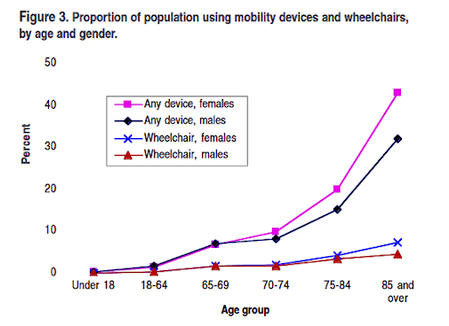
The life expectancy of someone in a wheelchair was found to be 49 years, which is less than that of anyone without a disability.
Scientists conducted extensive studies and found the health statistics that using a wheelchair can shorten a person’s lifespan.
Wheelchair users have a higher mortality risk than the general population.
In the U.S., there are an estimated 3.3 million wheelchair users, with 1.825 million of them aged 65 and over. Each year, 2 million more wheelchair users are added to the handicapped population.
The life expectancy of Paraplegics
According to research, the life expectancy estimate for a patient dealing with paraplegia is 12.8 years.
The 40-year survival rate for first-year people with a spinal cord injury is 62%.
But with time, life expectancy has increased in people with spinal cord injuries.
By 1998, the life expectancy for people with complete paraplegia was 86%, and for those with considerable motor preservation, it was 92%.
This enhanced life expectancy is attributable to greater survival from initial injuries and improved capacity to manage later problems such as bladder infections and pneumonia.
Life Expectancy of Quadriplegics
A 20-year-old who survives a severe spinal cord injury is expected to live 33.7 years.
Research has revealed pneumonia is a leading cause of death in people with quadriplegia.
Patients above the age of 55 and quadriplegics are included.
Although, many sufferers also commit suicide. Many individuals with post-traumatic anxiety due to spinal cord injury contribute to these high suicide rates.
Survival rates for those with tetraplegia are lower than those with paraplegia 40 years after their injuries occurred, at 47% vs. 62%.
But what are the most prevalent causes of disease and death among people who use wheelchairs?
Risk Factors Affecting Life Expectancy
The factors that determine one’s possible lifespan are varied.
Genes, physical activity, gender, eating habits, personal hygiene, medical care, and other factors all have an influence. These factors have played a considerable role in increasing life expectancy in disabled persons.

Mobility statistics graph showing the proportion of the population using mobility devices and wheelchairs by age and gender
However, we will just be discussing the longevity of wheelchair users.
- Poor Health Status
Wheelchair users have a lower health status than the average population.
It has been shown that using a wheelchair for a long time can lead to shoulder injuries, skin damage, and problems with the urinary tract. In contrast, respiratory diseases and influenza topped the mortality risk of spinal cord injury.
The most common causes of mortality for those with quadriplegia are urinary system infections and pulmonary embolisms.
Suicide, heart disease, malignancy, and septicemia are the leading causes of mortality for those with paralysis.
- Depression.
Compared to the general population, the physically disabled community may have higher rates of depression.
Another study found that 76.5% of people who said they had a physical disability also said they had signs of depression.
Disabled people experience depression 2– 10 times more often than others. Many factors can contribute to this data.
Mobility issues create irritation, embarrassment, frustration, and overall weakness.
Access limitations, social restrictions, work challenges, and poor health status might induce depression.
- Pressure Sores.
Those who rely on wheelchairs should always maintain a high personal hygiene standard due to the risk of developing a pressure sore.
Pressure sores, also called pressure ulcers, are blisters on the skin or in the tissues underneath. They are caused by constant pressure on the hips, heels, or lower back.
Chronic pressure sores can get infected and cause other problems, which are hard to heal.
- Lack Of Exercise.
Science has demonstrated for a long time that individuals who are physically active, walking around 7,000 to 8,000 steps per day (equivalent to 30 to 45 minutes of exercise), live longer than those who are not or use a mobility device.
Regular physical activity makes it much more likely that you will live a long and healthy life.
The Physical Activity Guidelines for Americans encourage strength training and aerobic exercise to improve well-being and avoid disease.
If the routine is kept up, it can reduce the mortality risk for wheelchair users.
- Health Service Access.
Despite this, evidence suggests that people with disabilities are less likely to receive high-quality treatment and preventative care and are more likely to suffer from chronic illnesses.
They could not get the medical attention they needed because of factors including cost, distance, or wait times.
Early deaths among wheelchair users overwhelmingly affected men (85.2%) and women (14.8%).
In another study on wheelchair users, almost 73.8% said they had difficulty accessing healthcare facilities, and (54.1%) felt they received incomplete care.
- Obesity.
Using a wheelchair usually results in significant physical changes that may affect the body composition of a disabled person.
These changes include obesity, an increased BMI, belly fat, and heart-related diseases, increasing high mortality risk.
According to studies, an increased BMI can also raise the risk of wheelchair accidents, making a manual wheelchair user’s life more difficult.
Real-Life Examples of Wheelchair Users

But despite all this, many people have had the best life, even being a constant wheelchair user.
Stephen Hawking was 21 when he was told he had two years to live after being diagnosed with amyotrophic lateral sclerosis (ALS). Despite being nearly completely paralyzed, he lived to be 76 and learned to communicate, making science easy for all of us and defying the terrible diagnosis.
Jerry, a wheelchair user and a former 53-year-old computer programmer who is now active in many sports as a competitor and a coach, just retired in 2009 with more than three decades of experience living with a disability. He had been partially paralyzed since 1976. He continues to live his life with great strength.
Wally Dutcher, 78 as of a year ago, is the oldest known quadriplegic alive. After being paralyzed at 19, he still managed to do a job and raise a family, and he now has a company with 162 employers working under him. Other notable achievements include a nomination from New Mobility magazine as “Person of the Year.”
John shares his story of being quadriplegic. He had been living with quadriplegia for the past 17 years. Like many other wheelchair users, he has been concerned about post-disability risk factors for mortality, but he is glad he is doing great.
Improving Life Expectancy
Most people associated with the use of mobility device have a diminished quality of life. The good news is that there are simple ways to counteract this trajectory from your end.
Some easy tips that can be followed are,
- Keep working.
Your impairment can be something other than the end of your career. There are many options, like working from home.
Even disabled people can receive assistance locating and commuting to work through various organizations. A job keeps you busy, gives you purpose, and connects you to others. - Get rid of the extra pounds.
This is the one advice we could provide to anyone with a disability that would impact their quality of life.
Diet and exercise are the two cornerstones of effective weight management.
They function similarly for both able-bodied persons and the vast majority of those with spinal cord injuries.
- Keep a Good Hygiene.
For optimal health, it’s essential to take care of the basics of personal hygiene, including washing your hair, nails, feet, genitalia, and teeth regularly. Move your position regularly to avoid pressure sores.
If you can’t move your wheelchair alone, ask for help at least once an hour to redistribute pressure.
- Getting more exercise is a must.
No matter what you may be able to perform, there is some sort of exercise that will benefit you.
According to research, many secondary health problems that might arise from spinal cord injury is preventable with regular exercise.
Examples include water aerobics, gardening, upper body training, and yoga.
People with spinal cord injuries, like anyone else with a disability, can benefit from the same lifestyle choices that extend the average life expectancy.
“Not being happy is not a result of using a wheelchair. We have a joyful and full life despite our difficulties.” Paul Amadeus Lane, a media professional, shared his view.
While you’re at it, consider a Hover Move Lite Folding Power Chair for better mobility. Like eyeglasses, you should get a proper wheelchair for your day-to-day activities.
So, achieving and maintaining good health should result in a longer life expectancy.

